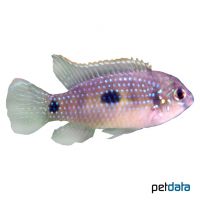African Butterfly Cichlid (Anomalochromis thomasi)
| African Butterfly Cichlid Anomalochromis thomasi | |
|---|---|
| Name | African Butterfly Cichlid |
| Name Lat. | Anomalochromis thomasi |
| Synonym | Paratilapia thomasi |
| Family | Cichlids |
| Family lat. | Cichlidae |
| Order | Cichlids |
| Order lat. | Cichliformes |
| Origin | Africa |
| Habitat | Forest streams |
| Diet | Omnivore |
| pH | 5.5-7.5 |
| Behavior | Peaceful |
| Keeping | Pair, group |
| Care Level | Easy |
| Reproduction | Substrate spawner |
| Breeding | Moderately difficult |
| Life Span | 3-5 years |
| Protection | No |
| Metric Units | |
| Size | 6-8 cm |
| Temperature | 23-27 °C |
| Hardness | 1-15 °dH |
| Aquarium | 80 cm / 110 l |
| US Units | |
| Size | 2.4"-3.1" |
| Temperature | 73-81 °F |
| Hardness | 18-267 ppm |
| Aquarium | 30 gal |
Distribution and habitat
The distribution area of the African Butterfly Cichlids is in West Africa, from Guinea through Sierra Leone to Liberia. There they live in clear, slow-flowing forest streams with stones, roots and fallen leaves as well as overhanging bank vegetation.
Maintenance
The aquarium should have a dense planting, with many hiding places (stones, roots) and offer free swimming space. A dark substrate covered with some foliage (e.g. sea almond leaves) and subdued light (floating plants) is ideal. Some flat stones, which serve as spawning ground, should not be missing
No ammonia, ammonium and nitrite should be detectable, the nitrate value should not exceed 100 mg/l. To ensure the water quality and oxygen content, a filter and heater adapted to the aquarium size is required, as well as lighting for the species-appropriate day-night rhythm of the animals.
Diet
The food supply consists of a high-quality dry food for cichlids (pellets, granules, chips), supplemented with live or frozen food, such as artemia, mysis, tubifex and mosquito larvae, or a commercially available frozen special food mixture for cichlids
It is recommended to feed small portions several times a day. Regular and varied feeding promotes health and prevents deficiency symptoms. Only feed as much as is eaten immediately (in a maximum of 10 minutes).
Behaviour and compatibility
These compatible and sociable fish should be kept in pairs or better in a group of 6-8 animals. They behave territorially only during the spawning season. However, keeping a group is only recommended in a larger and richly structured tank. A socialization with other peaceful dwarf cichlids and catfishes is well possible.
Basically, only compatible fish species with similar demands on water conditions and water temperature should be socialized.
Sex dimorphism
The slightly larger male is usually more intensely black in color. The females are somewhat rounder than the males at spawning time.
Reproduction and breeding
They are substrate spawners and practice intensive brood care (parental family). Once a harmonizing pair has been found, the female usually spawns up to 500 eggs on a well-cleaned, smooth stone. After about 48 hours, the fry hatch and are then housed by the parents in a prepared bottom pit until they swim freely after another 2-3 days. Often the school of fry is guarded by the parents for some time and led to the feeding places in the aquarium before the brood care ends
Fry must be fed several times a day with special rearing food (Artemia nauplii). In community tanks breeding is hardly possible, because the fry are easy prey.
Important
In their wide range there are some color forms. Further research will show whether they are only color forms or own species.
The foliage (sea almond tree, oak, etc.) not only provides cover, it enriches the water with humic substances, naturally lowers the pH value and, when rotting, promotes the development of microorganisms, which are a valuable secondary food source.
The well-being of the fish should be monitored regularly. Temperature should be checked daily, pH, hardness and nitrate levels at least every 14 days. Regular partial water changes are recommended, even when contaminant levels have not yet reached the upper limit. Sudden changes in water quality should be avoided. Newly introduced fish must be accustomed slowly to the water in the aquarium.
Further literature can be found in your pet store.
References
Text: Werner Winter; Image: petdata
Source: BMELV (1998): Tierschutzgutachten - Haltung von Zierfischen (Süßwasser); RIEHL & BAENSCH (2006): Aquarien Atlas Bd. 1, Mergus Verlag; ENGELMANN (2005): Zootierhaltung - Tiere in menschlicher Obhut: Fische, Verlag Harri Deutsch
- Gemäß § 21 Abs. 5 Tierschutzgesetz idgF
